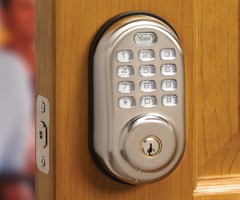What Is the Difference Between 5800 Wireless Technology and Z-Wave?
The primary difference between 5800 wireless technology and Z-Wave is that they are generally used for very different purposes. Honeywell 5800 Series sensors usually consist of security and life-safety devices, while Z-Wave devices are typically used for lifestyle enhancement purposes.
Both 5800 Series wireless sensors and Z-Wave devices will need to be enrolled with the panel in order to function. For 5800 Series devices, this is done through zone programming. Meanwhile, Z-Wave devices are learned-in using the panel's Z-Wave inclusion mode. Z-Wave devices can then be controlled manually or set up to trigger automatically using rules and scenes on the system. This cannot be done with 5800 Series devices.
One of the biggest differences between Z-Wave devices and 5800 Series sensors is that Z-Wave devices can be controlled remotely. This is done using the Total Connect app for Honeywell Systems, while 2GIG and Qolsys panels do this using the Alarm.com app. By using these respective apps, it is possible to control a Z-Wave device installed inside your home or business from anywhere in the world.
Although both Z-Wave devices and 5800 Series devices utilize methods of RF communication, Z-Wave signals are somewhat less secure than the signals used by 5800 Series devices, and have a shorter range. For this reason, Z-Wave devices are often non-security, home automation devices, such as light switches and thermostats. However, there is a notable exception of door locks, which often use Z-Wave connectivity. Meanwhile, 5800 Series sensors largely consist of security and life-safety devices, such as door and window contacts, motion sensors and smoke detectors.
Finally, Z-Wave devices are able to form a "mesh network", in which every Z-Wave device will repeat any Z-Wave signal that it detects. This means that a Z-Wave command signal, sent from the security panel will be passed along by other Z-Wave devices until it reaches the device the command is meant for. When many Z-Wave devices are added to a system, it creates an efficient network where all of the Z-Wave devices are interconnected. 5800 Series devices do not do this.
Did you find this answer useful?
We offer alarm monitoring as low as $10 / month
Click Here to Learn MoreRelated Products






Related Categories
- Wireless Alarm Systems
- Wireless Alarm Control Panels
- Locks
- DIY Wireless Security Systems
- Dimmers
- Lights
- Wireless Door Sensors and Window Alarm Sensors
- In-Wall Outlets
- Wireless Garage Door Alarm Sensors
- Wireless Smoke Detectors
- Garage Door Controllers
- Answered



